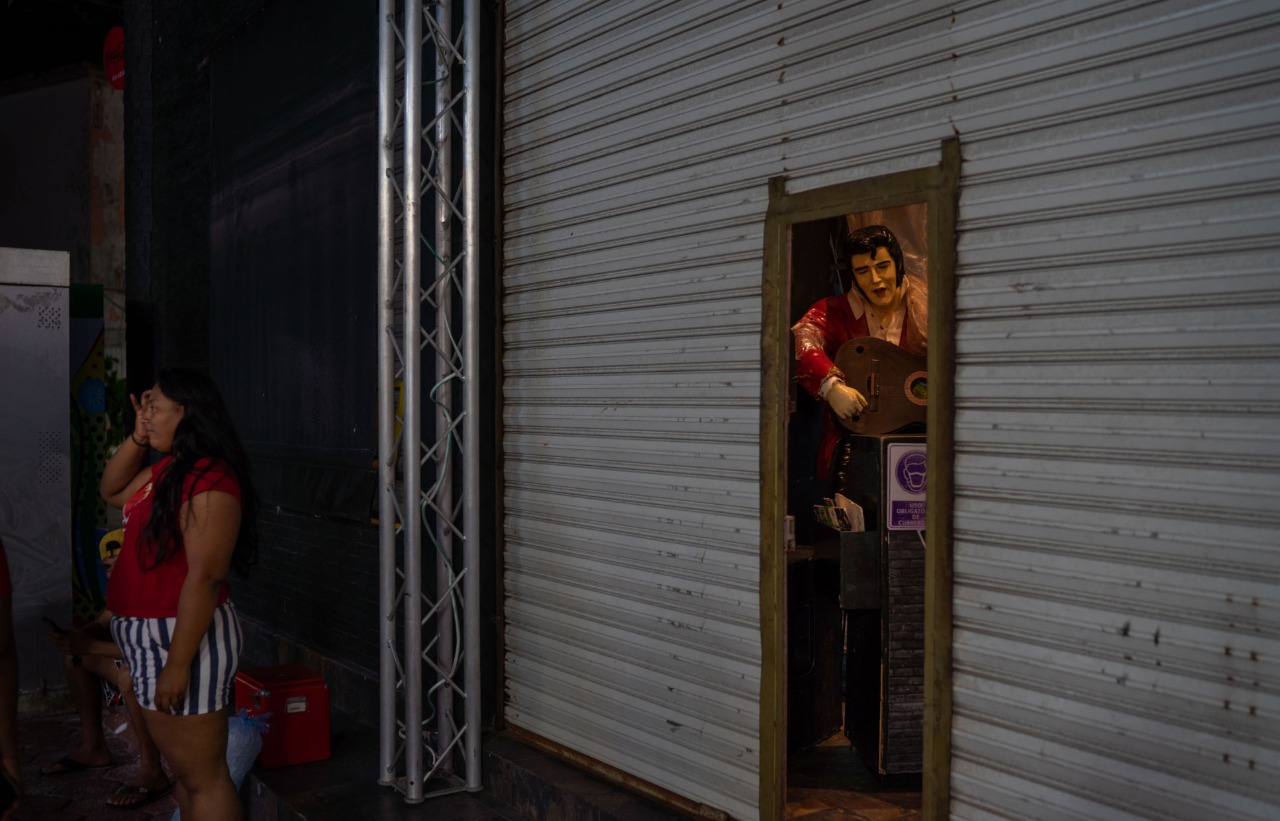Ernesto escuchó, apenas a unos cuantos metros de distancia, los insultos y golpes de una parte y los gritos lastimeros de la otra, pero no había mucho que pudiera hacer. Unos exigían el pago de una deuda y el otro les rogaba que pararan la tortura. Los atacantes, miembros del Cártel del Pacífico, uno de tantos grupos de la delincuencia organizada que asola a México; la víctima, un vendedor ambulante que no pagó a tiempo el “derecho de piso”; Ernesto, el testigo mudo, es el dueño del local donde todo sucedió, en la exclusiva zona hotelera de Cancún, una ciudad del Caribe mexicano que vive bajo la extorsión generalizada del crimen organizado. “Me decían ‘permíteme tu baño un ratito’ y metían a mi negocio a los vendedores ambulantes para ‘tablearlos’ [torturarlos] in broad daylight,” he recalls.
Ernesto is a prominent businessman from Cancun, one of the most important tourist destinations in Latin America. He agreed to tell his story under the condition of changing his name. He is the concessionaire of one of the places on the beach, offers tourist services in boats and he himself was a victim of extortion. In 2020, when the covid-19 pandemic was just beginning, members of the Cártel del Pacífico (CDP) showed up at their premises to demand the right to land. It was to pay 20,000 pesos a month or face the consequences. They did the same, he says, with the rest of the people who had commercial activities in the area. Cancun, in the southeast of the country and in the extreme north of the state of Quintana Roo, is the youngest city in Mexico and one of its main tourist centers. But, due to its geographical location, it is also a strategic route for the transfer of drugs from Central and South America to the United States. Due to this double condition: tourist destination and key point on the drug route, illegal activities such as drug dealing, arms, migrant and drug trafficking, money laundering, vehicle theft and extortion are the most profitable for criminal groups in the state, according to the Regional Center for Fusion and Intelligence of the Southeast (Cerfise), an intelligence agency of the Ministry of National Defense.

This report published by Gatopardo, Pie de Página, Aristegui Noticias, Espejo Magazine, Channel 44 and CONNECT tells that other side of Quintana Roo: a Caribbean paradise that has become fertile territory for extortion by armed groups. Nobody is saved, workers , businessmen, small merchants, independent workers and even street vendors are victims. Despite being a problem that few want to talk about, the state registers, on average, almost 10 extortion complaints a day . At the beginning, Ernesto says, a couple of subjects came to the beach to spend the afternoon. Then they approached the business owners. They asked to be allowed to charge their cell phones and, in the meantime, struck up a conversation. In time they realized that they were not going to bask in the sun, but to collect information. Once they identified the business owners, with their personal details and details about their business activities, they introduced themselves again, but this time in a threatening manner. “’We know who you are,’ they told me. They gave me details of my work, what I did, the position I had. They intimidated me. They were two people. First they told me that they wanted to charge me 20,000 pesos (per month), but we reached an agreement for 5,000 pesos,” says Ernesto. Once the beach was dominated, with the rest of the extorted restaurateurs, nautical and street vendors, and the sale of drugs already controlled, a group of about twenty members settled down, with different tasks: to monitor, distribute drugs, collect floor rights , threaten and beat those who opposed or were behind in payments. Three months after her arrival, the group raised her fee to 9,000 pesos a month (about $450), which she paid for nearly a year.
Extortion spreads Extortion in Cancun already affects all economic strata and different lines of business. From 2019 to October 2022, in the state, 13,012 anonymous complaints for extortion -in all its forms- were made to 089, the number that provides specialized attention in this crime to citizens. Of these, 5,406 (41.5%) were made from Cancun, the municipality with the most records. The threat of physical harm or death and the collection of property rights are among the most reported. A total of 337 business owners, shops or service providers dared to break the silence and reported to the SSP that they had been victims of extortion, according to the data requested and analyzed by CONNECT . Hotels, restaurants, auto repair shops, food outlets, doctor’s offices, beauty salons, and grocery stores are among the most common targets. Guillermo (a false name to protect his identity) is the owner of a popular chain of bars in Cancun called La Palapita, where seafood and beer are offered. He has been extorted several times since 2019, when he started his business. “The last time they extorted me was by phone, by WhatsApp. What they did was stop by my premises and record. They told me: ‘Look, I already have you located’. It was followed. Later, to put pressure on me, they began to publish on social networks that no one would go to my establishments if they did not want to die, because we were not aligning ourselves. [cediendo]. Later they sent me photos to my cell phone with images of the dead. ‘Look, I already killed three. You follow,’” she recalls. On May 5, 2022, the threats were fulfilled. One of the branches of the bar woke up in flames. Guillermo did not pay the floor fee. What he did was report to the Prosecutor’s Office that, in coordination with the SSP, he found who could be the mastermind: Magdiel N., a 34-year-old man, former employee of the Tabasco Attorney General’s Office and former preventive police officer in Cancun . He allegedly led a gang of extortionists, also retired police officers linked to the Sinaloa Cartel. Magdiel was arrested and is currently in judicial proceedings.

Complaints, folders, detainees Guillermo’s case is atypical: the vast majority of complaints of similar crimes go unpunished. The problem is that the bottleneck in judicial investigations is alarming, between 2019 and 2021 there were 9,932 emergency calls to 089 in the state motivated by extortion, only 883 cases resulted in formal complaints before the FGE and the SSP, while , arrested 31 people. In the specific case of Cancun, there are 3,126 calls, 303 folders and twenty-five detainees. But on five occasions (20% of the cases), in the control hearings, the judge in charge described the arrests as illegal or not in accordance with fundamental rights, according to information obtained through transparency and requested from the SSP, the FGE and the Judiciary of Quintana Roo. The Judiciary of Quintana Roo has obtained a single conviction for the crime of extortion, but on June 15, 2021, the judge of the Eighth Chamber Specialized in Traditional Criminal Matters, based in Cancun, resolved to replace the sentence, handed down a a year earlier, against Mauricio (a false name because the process is still ongoing), whom elements of the extinct Judicial Police allegedly tortured to extract the incriminating statement. The accounts of extortion in Cancun are, finally, like this: many complaints, few investigations, fewer arrests and torture.

Villas Otoch Paraiso: pay to live Outside the tourist pole, twenty kilometers from the hotel zone, on the outskirts of Cancún, is Villas Otoch Paraíso, a neighborhood that lives the same criminal siege, although on a different scale, perhaps worse. Not only is it the most overcrowded colony, but, for this reason, it is also the most violent in the entire Mexican Caribbean. And the chaos has been taken advantage of by criminal groups to impose their own order. The criminal group to which obedience and tribute are owed depends on the part of the colony where one lives. The streets of the eastern zone, from Tulipanes avenue to the first Oxxo, are territory controlled by the Los Pelones cartel. The following streets are owned by the Jalisco Nueva Generación Cartel. The ones in the extreme west are administered between Barrio 18 and other cliques that have crossed the Central American border to settle in this place, according to a source who was born, grew up and lives in Villas Otoch Paraíso, and who now performs intelligence tasks. It is a tense and weak order that is redefined from time to time, as one organization or another conquers every span. These reconfigurations generate violence. According to the intelligence source, the CJNG is pushing to control more and more space.
This October, the SSP and the FGE dealt with various crimes, including an extortion report that exemplifies the level that this crime has reached. Juana (a false name to protect her identity), a neighbor who lives in one of the narrow corridors of the subdivision, began to charge her five hundred pesos a week to let her leave her house. Her neighbors were in the same situation. “Do you know what is worst?” says the source who does intelligence work, “that those who extort are children, one twelve years old, two thirteen, one fifteen and another sixteen. Children playing at being delinquents, at replicating what they see around them”. In addition to Juana, internet installers, truck drivers, taxi drivers and practically all the tenants of Villas Otoch Paraíso are extorted. Cases like Francisco’s (a false name to protect the safety of his family) show what happens when someone doesn’t pay at Villa Otoch Paraíso. Francisco was one of the few who refused to do so. The merchant ran the most prosperous greengrocer in the neighborhood for four years, on Leona Vicario Avenue. He was executed along with one of his children in 2018. The rest of the family fled. Now the survivors are part of more than 350,000 cases of forced internal displacement due to violence in Mexico. If you are interested in reading more cases of victims of extortion in Cancun and learning more about this problem, Enter the multimedia special here . * Extortion in the paradise of the Mexican Caribbean is an investigation by Ricargo Hernández Ruiz to Leopard, Footer, Aristegui News, Mirror Magazine, channel 44 and CONNECT
]]>Source link















